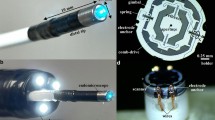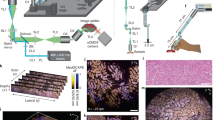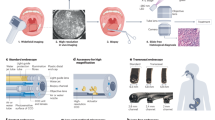Abstract
Recent advances in endoscopic imaging technology have enabled the visualization of early-stage cancer and its precursors in the gastrointestinal tract. Chromoendoscopy, magnifying endoscopy, endoscopic optical coherent tomography, spectroscopy, and various combinations of these technologies, are all important for the recognition of small and unclear lesions. To observe cancer cells in vivo, two types of ultra-high magnifying endoscope—'laser-scanning confocal endoscopy series' and 'contact endoscopy series'—that have a maximum of more than 1,000× magnifying power have been developed. These endoscopes can generate high-quality images of both living cancer cells and normal cells in the gastrointestinal tract, with a quality comparable to that possible with conventional cytology. These novel imaging technologies may make in vivo histological diagnosis by virtual histology possible.
This is a preview of subscription content, access via your institution
Access options
Subscribe to this journal
Receive 12 print issues and online access
$209.00 per year
only $17.42 per issue
Buy this article
- Purchase on Springer Link
- Instant access to full article PDF
Prices may be subject to local taxes which are calculated during checkout


Similar content being viewed by others
References
Hirschowitz BI et al. (2002) The history of endoscopy. In Gastroenterological Endoscopy 2–45 (Classen M et al. eds) Thieme: Stuttgart, New York
Lambert R (2004) Diagnosis of esophagogastric tumors. Endoscopy 36: 110–119
Lambert R (1998) Mass screening programs in Japan: what can we learn in the West? Endoscopy 30: 721–723
Endo M et al. (1986) How can we diagnose the early stage of esophageal cancer? Endoscopy 18: 11–18
Pathirana A and Poston GJ (2001) Lessons from Japan – endoscopic management of early gastric and oesophageal cancer. Eur J Surg Oncol 27: 9–16
Brodmerkel GJ (1971) Schiller's test, an aid in esophagoscopic diagnosis. Gastroenterology 60: 813–821
Inoue H et al. (2001) Lugol chromoendoscopy for esophageal squamous cell cancer. Endoscopy 33: 75–79
Canto MI (1999) Staining in gastrointestinal endoscopy: the basics. Endoscopy 31: 479–486
Kudo S et al. (2001) Pit pattern in colorectal neoplasia: endoscopic magnifying view. Endoscopy 33: 367–373
Kudo S et al. (1996) Diagnosis of colorectal tumorous lesions by magnifying endoscopy. Gastrointest Endosc 44: 8–14
Yao K et al. (2002) Novel magnified endoscopic findings of microvascular architecture intramucosal gastic cancer. Gastrointest Endosc 56: 279–284
Inoue H et al. (1996) Ultra-high magnification endoscopy of the normal esophageal mucosa. Dig Endosc 8: 134–138
Inoue H et al. (1997) Ultra-high magnification endoscopic observation of carcinoma in situ of the esophagus. Dig Endosc 9: 16–18
Kumagai Y et al. (2002) Magnifying endoscopy, stereoscopic microscopy, and the microvascular architecture of superficial esophageal carcinoma. Endoscopy 34: 369–375
Kumagai Y et al. (2002) Dynamism of tumour vasculature in the early phase of cancer progression: outcomes from oesophageal cancer research. Lancet Oncol 3: 604–610
Gono K et al. (2004) Appearance of enhanced tissue features in narrow-band endoscopic imaging. J Biomed Opt 9: 568–577
Yoshida T et al. (2004) Narrow-band imaging system with magnifying endoscopy for superficial esophageal lesions. Gastrointest Endosc 59: 188–195
Hamamoto Y et al. (2004) Usefulness of narrow-band imaging endoscopy for diagnosis of Barrett's esophagus. J Gastroenterol 39: 14–20
Inoue H et al. (1994) Endoscopic mucosal resection with a cap-fitted panendoscope for esophagus, stomach, and colon mucosal lesions. Gastrointest Endosc 40: 263–264
Silverstein FE et al. (1989) Experimental evaluation of an endoscopic ultrasound probe. Gastroenterology 96: 1058–1062
Roesch T (1995) Endosonographic staging of esophageal cancer: a review of literature results. Gastrointestinal Endosc Clin N Am 5: 537–547
Huang D et al. (1991) Optical coherence tomography. Science 254: 1178–1181
Izatt JA et al. (1996) Optical coherence tomography and microscopy in gastrointestinal tissues. IEEE Trans Biomed Eng 2: 1017–1028
Pfau PR et al. (2001) Endoscopic diagnostics. Gastroenterology 120: 763–781
Dacosta RS et al. (2002) New optical technologies for earlier endoscopic diagnosis of premalignant gastrointestinal lesions. J Gastroenterol Hepatol 17: S85–S104
Wong KS and Marcon NE (2003) Fluorescence and Raman spectroscopy. Gastrointest Endosc Clin N Am 13: 279–296
Jansen A and Kortum R (1995) Raman spectroscopy for the detection of cancers and precancers. J Biomed Opt 1: 35–70
Haringsma J et al. (2001) Autofluorescence endoscopy: feasibility of detection of GI neoplasms unapparent to white light endoscopy with an evolving technology. Gastrointest Endosc 53: 642–650
Mayinger B et al. (2001) Light-induced autofluorescence spectroscopy for the endoscopic detection of esophageal cancer. Gastrointest Endosc 54: 195–201
Namihisa A et al. (2001) A new technique: light-induced fluorescence endoscopy in combination with pharmacoendoscopy. Gastrointest Endosc 53: 343–348
Mayinger B et al. (2001) Endoscopic fluorescence spectroscopy in the upper GI tract for the detection of GI cancer: initial experience. Am J Gastroenterol 96: 2616–2621
Inoue H et al. (2000) A novel method of virtual histology utilizing laser-scanning confocal microscopy for untreated fresh specimens of the gastrointestinal mucosa. Endoscopy 32: 439–443
Cavanagh HD et al. (1993) The application of confocal microscopy to the study of living systems. Neurosci Biobehav Rev 17: 483–489
Corcuff P and Leveque JL (1993) In vivo vision of the human skin with the tandem scanning microscope. Dermatology 186: 50–54
Delaney PM et al. (1994) Fibre-optic laser scanning confocal microscope suitable for fluorescence imaging. Appl Opt 33: 573–577
Dickensheets Dl and Kino GS (1996) Micromachines scanning confocal optical microscope. Opt Lett 10: 764–766
Mizuno H (2000) Micromachines. J Jpn Soc Bronchol 22: 590–595
Inoue H et al. (2003) Development of virtual histology and virtual biopsy using laser-scanning confocal microscopy. Scand J Gastroenterol 38: 37–39
Sakashita M et al. (2003) Virtual histology of colorectal lesions using laser-scanning confocal microscopy. Endoscopy 35: 1–6
Lawrence AY (1986) Fluorescein angiography complication survey. Ophthalmology 93: 611–617
McLaren WJ et al. (2002) In vivo detection of morphological and microvascular changes of the colon in association with colitis using fibreoptic confocal imaging (FOCI). Dig Dis Sci 47: 2424–2433
Sokolov K et al. (2002) Endoscopic microscopy. Dis Markers 18: 269–291
Kiesslich R et al. (2004) Confocal laser endoscopy for diagnosing intraepithelial neoplasias and colorectal cancer in vivo. Gastroenterology 127: 706–713
Hamou JE (1980) Microendoscopy. Acta Endoscopia 10: 415–422
Andrea M et al. (1995) Contact endoscopy of the vocal cord: normal and pathological patterns. Acta Otolaryngol 115: 314–316
Kumagai Y et al. (2004) Magnifying chromoendoscopy of the esophagus: in vivo pathological diagnosis using an endocytoscopy system. Endoscopy 36: 590–594
Inoue H et al. (2004) In vivo observation of living cancer cells in the esophagus, stomach, and colon using catheter-type contact endoscope, 'endo-cytoscopy system'. Gastrointest Endosc Clin N Am 14: 589–594
Tada M et al. (1982) A new method for the ultra-magnifying observation of the colon mucosa. Kyoto Pref Univ Med 91: 349–354
Olliver JR et al. (2003) Chromoendoscopy with methylene blue and associated DNA damage in Barrett's oesophagus. Lancet 362: 373–374
Kiesslich R et al. (2003) Methylene blue-aided chromoendoscopy for the detection of intraepithelial neoplasia and colon cancer in ulcerateive colitis. Gastroenterology 124: 880–888
Author information
Authors and Affiliations
Corresponding author
Ethics declarations
Competing interests
The authors declare no competing financial interests.
Rights and permissions
About this article
Cite this article
Inoue, H., Kudo, Se. & Shiokawa, A. Technology Insight: laser-scanning confocal microscopy and endocytoscopy for cellular observation of the gastrointestinal tract. Nat Rev Gastroenterol Hepatol 2, 31–37 (2005). https://doi.org/10.1038/ncpgasthep0072
Received:
Accepted:
Issue Date:
DOI: https://doi.org/10.1038/ncpgasthep0072
This article is cited by
-
Cholecystokinin as a potent diagnostic marker for gastric cancer
BioChip Journal (2017)
-
Endocytoscopic observation of various types of esophagitis
Esophagus (2016)
-
Combination of miRNA and RNA functions as potential biomarkers for gastric cancer
Tumor Biology (2015)
-
Clinical usefulness of endocytoscopy in the remission stage of ulcerative colitis: a pilot study
Journal of Gastroenterology (2015)
-
Probe-Based Confocal Laser Microscopy Identifies Criteria Predictive of Active Celiac Sprue
Digestive Diseases and Sciences (2012)



